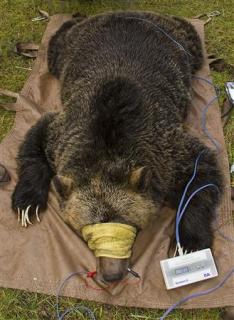Hungry Bears Spell Trouble For Humans In Rockies
Date: 30-Sep-10
Country: USA
Author: Laura Zuckerman

A female bear cub captured with its mother and relocated away from
human habitation.
Photo: Reuters/Derek Reich/Montana Fish, Wildlife and
Parks/Handout/Files Related News
A shortage of berries and other foods that hungry bears normally rely on to bulk up before hibernation has sent conflicts with humans spiraling to unprecedented levels in the Rocky Mountain West.
Wildlife officials in parts of Idaho, Montana and Wyoming say they are experiencing a record year for so-called problem bears, which wander from the wilds into civilization -- and into trouble.
State and federal bear biologists say they are overrun this season with reports about errant grizzly and black bears foraging in everything from garbage cans to garages, in every place from golf courses to city centers.
"I've had as many as 20 calls a day," said Tim Manley, a grizzly bear management specialist with the Montana Fish, Wildlife and Parks Department.
Scientists say bears this year are wrestling with challenging conditions. For starters, the mild winter meant bears emerging from their dens in the spring encountered fewer weakened or winter-killed wildlife like elk to prey on.
And late spring snows, which blanketed the high country and pushed bears to lower elevations earlier, delayed or even destroyed the crop of fruit-producing shrubs bears favor, such as huckleberries and hawthorns.
Conflicts between wildlife and humans almost always center on food, and when supplies of nourishment are low in the mountains, bears congregate closer to the valleys, where people live and livestock is conveniently located.
BERRIES FOR BEARS
Manley, based in the Flathead Valley of northwest Montana, is among wildlife agents tracking 18 grizzlies, more than the usual number, that have been trapped since spring and in most cases relocated, a strategy for managing nuisance bears without killing them.
In neighboring Wyoming, the problem is more pronounced. Wildlife officials have grappled with a record 52 grizzly captures stemming from conflicts with people and livestock, said Mark Bruscino, head of the bear program for the Wyoming Game and Fish Department. That's double the number from an average year.
"Bears are getting bolder in seeking foods," Bruscino said.
The trend for grizzlies -- outsize, hump-shouldered bears listed as a threatened species in and around Yellowstone National Park -- is compounded this year by a decline of the whitebark pine, a high-elevation tree whose nuts make up a crucial part of the grizzly diet.
Chuck Schwartz, head of a group of government scientists who monitor the estimated 600 grizzlies in the Yellowstone region -- parts of Idaho, Montana and Wyoming -- said conflicts with bears invariably rise when food supplies fall.
"If a natural food source is scarce, bears don't curl up and die -- they just go looking for something to eat," he said.
Both grizzlies and black bears are considered opportunistic omnivores, animals that will switch from fruit to fish, from nuts to meat -- or any combination in between -- according to the dictates of their environment.
That drive for food turned deadly on July 28, when a mother grizzly killed a camper and injured two others at a Montana campground. Earlier that month, a grizzly killed an elderly hiker in northwestern Wyoming.
By contrast, encounters this year with black bears have been tame -- but prolific. A woman near Missoula, Montana, last Thursday fended off a charging bear with a zucchini. In central Idaho, residents have reported bears raiding bird feeders, guzzling from water jugs and raiding bee hives.
"We're seeing an unusual amount of bear activity this year," said Bret Stansberry, wildlife biologist with the Idaho Fish and Game office in Salmon.
It will be late October before most black bears will have entered their dens, where they will snooze away the winter. Grizzlies usually den by the end of November.
(Editing by Steve Gorman, Jonathan Oatis and Sandra Maler)